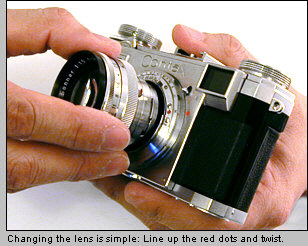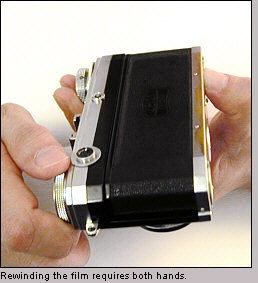.jpg) To put it bluntly, this isn't a camera for everyone. The bodies are
expensive. The lenses can be expensive, with some extremely hard to find
(i.e., expensive). Accessories are equally difficult to locate and expensive ... you get
the idea. But if you're
persistent and patient, you can build a top-shelf classic camera kit.
To put it bluntly, this isn't a camera for everyone. The bodies are
expensive. The lenses can be expensive, with some extremely hard to find
(i.e., expensive). Accessories are equally difficult to locate and expensive ... you get
the idea. But if you're
persistent and patient, you can build a top-shelf classic camera kit.
The images on the negatives are very closely spaced ... less than one millimeter apart. It makes full use of the negative in a way that most cameras don't. Of course, it makes it that much more difficult when having prints made, because most modern day negative carriers are sized for a slightly smaller image. And those from photo labs generally are even smaller. That's something you'll need to keep in mind when shooting – unless you make your own negative carriers.
 If you live in an area
where cameras are plentiful or there are a lot of estate auctions, then
you might get lucky. Otherwise, you'll probably have to buy from the Internet
auction site eBay, where
you're at the mercy of the online sharks, often competing with collectors,
other photographers and dealers. The prices generally are cheaper than
buying from a dealer. The downside is that you can't physically inspect
the cameras, so you're buying blind in many cases. Keep that in mind when
you place your bid.
If you live in an area
where cameras are plentiful or there are a lot of estate auctions, then
you might get lucky. Otherwise, you'll probably have to buy from the Internet
auction site eBay, where
you're at the mercy of the online sharks, often competing with collectors,
other photographers and dealers. The prices generally are cheaper than
buying from a dealer. The downside is that you can't physically inspect
the cameras, so you're buying blind in many cases. Keep that in mind when
you place your bid.
The camera's infinity lock can sometimes be frustrating when trying to focus – especially if you use the traditional method of focusing with the lens barrel, rather than the focus wheel. After a week or so of steady use, you get used to it. You'll automatically reach for the infinity lock.
 The viewfinder image is a medium green, although the
rangefinder rectangle is yellow and clearly visible. There are no
framelines in the viewfinder, so you're hoping that what you compose is
close to what you'll get. Compared with a modern-day camera, it seems
archaic. And it is.
The viewfinder image is a medium green, although the
rangefinder rectangle is yellow and clearly visible. There are no
framelines in the viewfinder, so you're hoping that what you compose is
close to what you'll get. Compared with a modern-day camera, it seems
archaic. And it is.
Advancing and rewinding the film takes time. There is no advance lever or rewind crank. Rewinding is an exercise in patience: It takes strong fingers, a strong wrist and as a rough guide, you'll twist the rewind knob two times for every frame. Not two revolutions, mind you, but two twists of your wrist.
 Loading the film is simple, once you get the hang of
it. Just keep a firm grip on the plastic film spool. Unloading the film
requires a bit of maneuvering with your hands, as you try to keep your
fingers off the viewfinder/rangefinder windows and lens.
Loading the film is simple, once you get the hang of
it. Just keep a firm grip on the plastic film spool. Unloading the film
requires a bit of maneuvering with your hands, as you try to keep your
fingers off the viewfinder/rangefinder windows and lens.
Almost all of these cameras will need serviced. It might be anything from a light cleaning to a thorough overhaul. The work itself isn't difficult, but you need to have a basic understanding of how cameras work plus the proper tools. And intuitive mechanical ability is a big plus.
So if this camera is such a pain to use, what's the payoff? What's in it for you? Simply put: the images. The Carl Zeiss lenses produce photos that are distinctive and timeless. They are at once both sharp and soft, capturing detail while lending a gentle quality to them. That seems contradictory, but it's true.